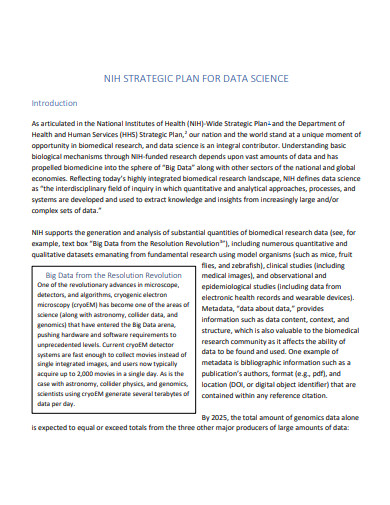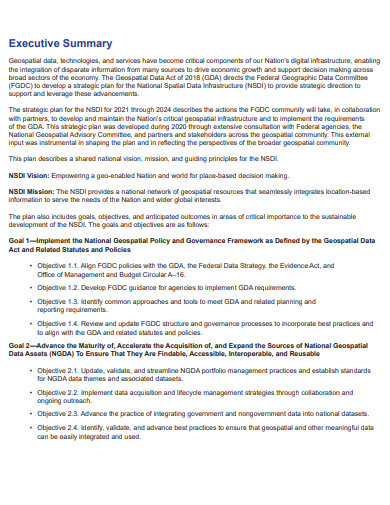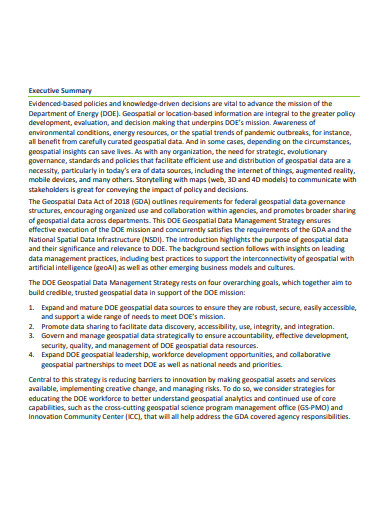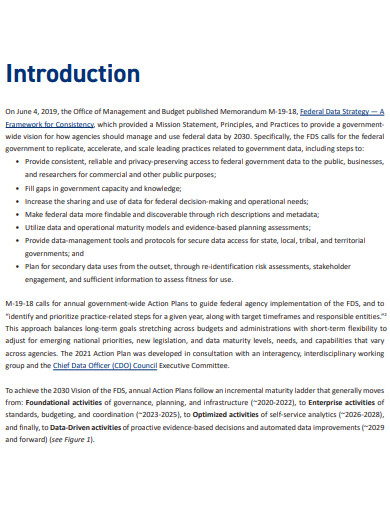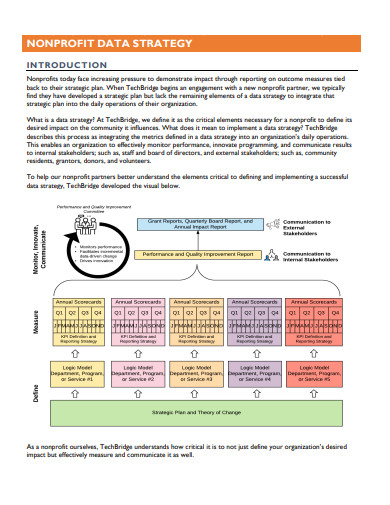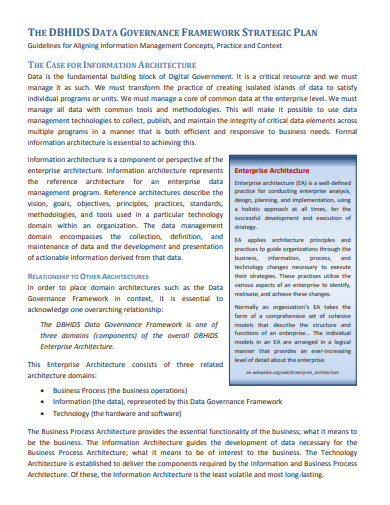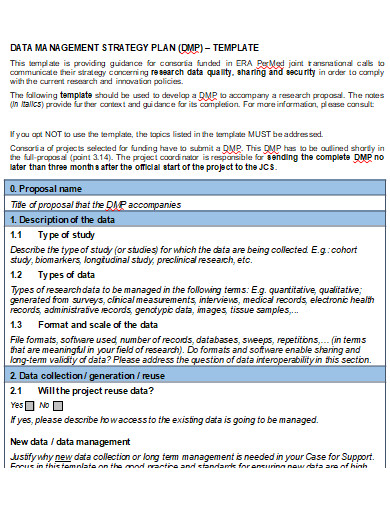Despite significant long-term investments in data management, many organizations’ data problems continue to worsen. One reason for this is that data has traditionally been regarded as a component of a technology project rather than a corporate asset. As a result, it was assumed that traditional application and database planning efforts would suffice to address persistent data problems. When it comes to strategic plans and road maps, there’s no shortage of big-picture thinking. For many people, such efforts are a novelty. Indeed, strategic plans frequently produce few tangible results for organizations – only a slew of meetings and paperwork. An effective plan, on the other hand, will define realistic goals as well as a road map that lays out a clear path for completing the task.
10+ FREE Data Strategy Plan Samples
You have data if you have a business, but data alone won’t help you optimize and improve it. If you want to turn data into value, you’ll need a data strategy. The tools, processes, and rules that specify how to manage, analyze, and act on business data are referred to as data strategies. A data strategy can assist you in making data-driven decisions. It also aids in the security and compliance of your data.
1. Data Strategy Plan

2. Data Analysis Strategic Plan
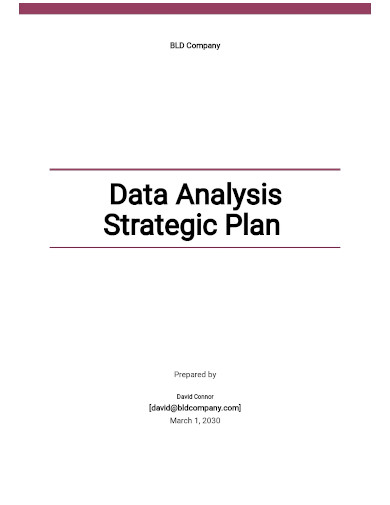
3. Strategic Plan for Data Science
4. National Action Plan Data Strategy
5. Data Infrastructure Strategic Plan
6. Data Management Strategy Plan
7. Federal Data Strategy Action Plan
8. Sample Data Strategy Plan
9. Nonprofit Data Strategy Plan
10. Data Governance Framework Strategic Plan
11. Data Strategy Plan Example
Importance of Data Strategy
- It helps unlock the power of data – The value of data is well understood today. Most businesses recognize data as a valuable resource rather than a byproduct of various business activities. Unlocking that value, on the other hand, can be difficult. Many businesses are unsure how to respond to the question, “What is big data?” They may also be unsure of what data to collect or how to do so efficiently. They must also convert the data into a usable format, share it across the organization, and derive insights from it once it has been collected. A data strategy instructs employees on how to do these things and ensures that they are done consistently throughout the organization.
- It has an increasing volume of data – The amount of data available to businesses is rapidly increasing — 90 percent of the world’s data became available in just the last two years. As the volume of data grows, managing it becomes more difficult, necessitating the development of a data strategy. Some businesses may have been capable of managing their data using common knowledge in the past. While this method was not the most efficient, it did not take long due to the small amount of data.
- It improves data management – Data access and usage are company-wide requirements that affect every group and level of management. That is why a company-wide solution, such as a data strategy, is beneficial. Developing a company-wide strategy improves data management across the board and ensures that different departments work together rather than against one another.
- Helps you use resources in an efficient manner – Every department and individual will have guidelines to follow in terms of what format data should be in if they use a data management strategy. While they may make changes as needed, the data should be in a usable format when it is retrieved. Because the data is in a standard format, it can be easily shared between departments. Having a company-wide strategy allows you to make better use of your resources while lowering your data-related costs.
FAQs
What is the benefit of eliminating data silos?
Eliminating data silos improves data accessibility and fosters collaboration among various departments within a company. One of your data strategy’s goals should be to integrate all of your company’s data into a single system that everyone can access and use. This makes it easier for people to get data and opens the door to new data-driven projects that would otherwise go unnoticed.
What are the components of data strategy?
- Business strategy – Your data strategy should support and advance your overall business strategy, which encompasses the processes you use to run and improve your company.
- Organizational roles – In order to facilitate collaboration and avoid duplication, a data strategy should pay attention to organizational roles by detailing who does what with the data.
- Data architecture – The tools and processes that allow you to work with and analyze data make up your data architecture. Various types of on-premises and cloud-based hardware and software may be included in these elements.
- Data management – All team members are encouraged to think of data as a business asset rather than a byproduct of business operations by using data management. When working with data, it encourages everyone in your organization to follow policies.
While a data strategy can include a variety of elements, it must start with a clear understanding of the key problem(s) you’re trying to solve. With this key understanding, you’ll be in a better position to maximize the value data can bring to your company. It’s not about collecting as much data as possible; it’s about collecting the data that’s most useful.
Related Posts
FREE 28+ Sample Action Plan Templates in MS Word PDF
FREE 10+ Quality Assessment Plan Samples in MS Word Google ...
FREE 10+ Data Analysis Project Plan Samples in MS Word Google ...
FREE 8+ Sales Plan and Sales Strategy Samples in PDF MS Word
FREE 3+ Exit Strategy Business Plan Samples in PDF
FREE 10+ Retail Action Plan Samples in PDF MS Word
FREE What Should Be Included in a Marketing Plan [ How to Write ...
FREE 10+ Simple Quality Control Plan Samples in MS Word ...
FREE How to Write a Marketing Plan for a Business [ With Samples ]
FREE 10+ Policy Implementation Plan Samples [ Environmental ...
FREE 10+ E-commerce Marketing Plan Samples in MS Word ...
FREE 9+ Strategic Action Plan Samples in PDF MS Word
FREE 5+ Digital Marketing Strategy Plan Samples in MS Word ...
FREE 10+ Charity Strategic Plan Samples & Templates in MS Word ...
FREE 10+ Learning Strategic Plan Samples [ Early, Online ...

